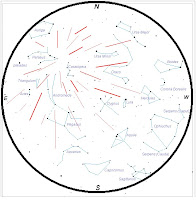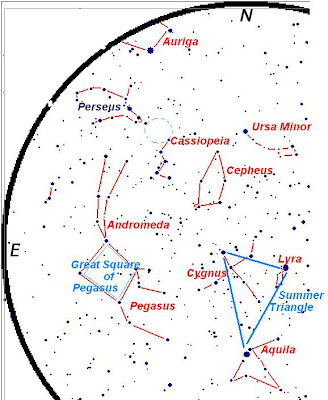.....The constellation of Lyra is small, but it holds one corner of the Summer Triangle, and the fifth brightest star in the sky - the second brightest star in the northern sky. Lyra contains the star Vega noteworthy because this constellation, unlike some others like Scorpius, is quite high in the sky in the northern hemisphere, passing directly overhead of the southern United States. (Spookily, Vega passes almost directly overhead of Washington D.C..)
.....While this is something that I have done for the last few constellations, I have a more well-defined standard format for how constellations are presented. The first map shows the sky, centered on the constellation in question, with a radius of thirty degrees. For all but the largest constellations (and Lyra is kind of small), this will show a number of bordering constellations. This gives us a standard starting point, and helps us find the constellation in the sky. (In the case of Lyra, this helps us find other constellations as Vega is pretty hard to miss.)
.....Zooming in on Lyra (this map has a radius of eight degrees, we see Lyra as it is usually portrayed, a triangle of stars sharing a corner with a parallelogram.
.....Looking up on a summer night, Lyra seems quite and serene. Less than a dozen stars, one bright, but otherwise quite. Actually, Lyra has some notable weirdness to its stars. Vega is larger and more luminous than the Sun, but its brightness in the sky is due to its closeness. Vega is only a little more than 25 light years away, so the light that you can see from Vega tonight left in late April of 1986. Being close, Vega is relatively easy to study, and astronomers have fond a massive disk of gas and dust around Vega, with irregularities that might indicate the presence of planets. Weirder than this is the other star only in the "triangle" of Lyra, designated Epsilon Lyrae. Through binoculars (and on the second map), this star is revealed as a pair of stars close together in the sky. This is no coincidence; those are actually orbiting a common center of mass - but it get stranger. Looking through a telescope with high magnification on a clear, steady night, each of these stars is revealed as a double star in their own right, so this is also called the Double-Double, four stars orbiting in pairs that orbit each other.
.....Even weirder is Sheliak, or Beta Lyrae. Sheliak is 882 light years away, so for the light reaching us (from 1129, the year of the Council of Troyes franchising the Knights Templar - let's see what Dan Brown does with that) to still make Sheliak the second brightest star in constellation must be something outstanding indeed! Sheliak is also a double star; nothing strange in this, most stars orbit in pairs (or more). In Beta Lyrae's case, the two stars are so close together that the gravity of each star distorts the other, and material is pulled off of one towards the other. These stars are orbiting so quickly that as the stream of gas moves toward the hotter star, it misses the star, building up into a disk. Even this disk overflows, with material escaping into space from the poles, and leaking out from the opposite side of the accretion disk
.....Because Lyra is a fairly tiny constellation, I have included two telescope objects on this map as well. This kind of skips ahead in my plans, since I intend to discuss these objects on my next tour of the constellations, but if you have even the smallest of telescopes, the object M57, aka the Ring Nebula, is straightforward to find between Sulafat and Sheliak. (When I was in seventh and eighth grade, my backyard telescope had a lens actually slightly smaller than the human eye, and a tripod with legs six inches long that I would need to balance on the posts of a chain-link fence. I could find Jupiter, Saturn, the Orion Nebula, the Andromeda Galaxy ... and the Ring. The other deep-sky object is M56, a globular cluster that is one of literally dozens of globular clusters that can be seen in the summer sky.
.....Even weirder is Sheliak, or Beta Lyrae. Sheliak is 882 light years away, so for the light reaching us (from 1129, the year of the Council of Troyes franchising the Knights Templar - let's see what Dan Brown does with that) to still make Sheliak the second brightest star in constellation must be something outstanding indeed! Sheliak is also a double star; nothing strange in this, most stars orbit in pairs (or more). In Beta Lyrae's case, the two stars are so close together that the gravity of each star distorts the other, and material is pulled off of one towards the other. These stars are orbiting so quickly that as the stream of gas moves toward the hotter star, it misses the star, building up into a disk. Even this disk overflows, with material escaping into space from the poles, and leaking out from the opposite side of the accretion disk
.....Because Lyra is a fairly tiny constellation, I have included two telescope objects on this map as well. This kind of skips ahead in my plans, since I intend to discuss these objects on my next tour of the constellations, but if you have even the smallest of telescopes, the object M57, aka the Ring Nebula, is straightforward to find between Sulafat and Sheliak. (When I was in seventh and eighth grade, my backyard telescope had a lens actually slightly smaller than the human eye, and a tripod with legs six inches long that I would need to balance on the posts of a chain-link fence. I could find Jupiter, Saturn, the Orion Nebula, the Andromeda Galaxy ... and the Ring. The other deep-sky object is M56, a globular cluster that is one of literally dozens of globular clusters that can be seen in the summer sky.
.....As a last point, I have previously discussed how the north star can be hard to find because the constellation it is in is so faint. Also, there are a number of people who (if pressed) will claim that the North Star is the brightest star in the sky. (There is at least one who simply tongue-in-cheek defines the North Star this way be fiat. Her car has GPS, so navigating by the stars is not a daily requirement.) The North Star is not the brightest, but due to the Earth's long, slow 26,000 year wobble on its axis, if you wait about twelve thousand years, you (or your head in a jar) can see Vega as the star closest to the pole.
























